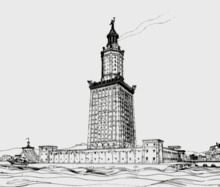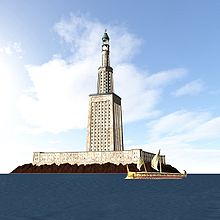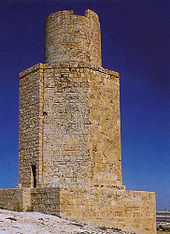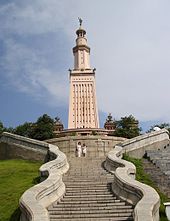
Lighthouse of Alexandria
Background Information
Arranging a Wikipedia selection for schools in the developing world without internet was an initiative by SOS Children. Child sponsorship helps children one by one http://www.sponsor-a-child.org.uk/.
 |
|
| Drawing by archaeologist Hermann Thiersch (1909). | |
| Location | Pharos, Alexandria, Egypt |
|---|---|
| Coordinates | 31°12′50.15″N 29°53′08.38″E Coordinates: 31°12′50.15″N 29°53′08.38″E |
| Year first constructed | c. 280 BC |
| Deactivated | 1303/1323 |
| Foundation | Stone |
| Construction | Masonry |
| Height | 393–450 ft (120–140 m) |
| Range | 47 km (29 mi) |
The Lighthouse of Alexandria, sometimes called the Pharos of Alexandria (in Ancient Greek, ὁ Φάρος της Ἀλεξανδρείας), was a lofty tower built by the Ptolemaic Kingdom between 280 and 247 BC on the coastal island of Pharos at Alexandria, Egypt for the purpose of guiding sailors into the port.
With a height variously estimated at somewhere between 393 and 450 ft (120 and 140 m), it was one of the tallest man-made structures on Earth for many centuries, and was regarded as one of the Seven Wonders of the Ancient World. Badly damaged by three earthquakes between 956 and 1323, it then became an abandoned ruin. It was the third longest surviving ancient wonder (after the Mausoleum at Halicarnassus and the still extant Great Pyramid of Giza) until in 1480 the last of its remnant stones were used to build the Citadel of Qaitbay on the site. In 1994, French archeologists discovered some remains of the lighthouse on the floor of Alexandria's Eastern Harbour.
Origin
Pharos was a small island just off the coast of the Nile Delta's western edge. In 332 BC when Alexander the Great founded the city of Alexandria on an isthmus opposite to Pharos, he caused the island to be united to the coast by a mole nearly a mile long (1260 m) called the Heptastadion ("seven stadia"—a stadium was a Greek unit of length measuring approximately 180 m). The east side of the mole became the Great Harbour, now an open bay; on the west side lay the port of Eunostos, with its inner basin Kibotos, now vastly enlarged to form the modern harbour. Today's city development lying between the present Grand Square and the modern Ras al-Tiin quarter is built on the silt which gradually widened and obliterated this mole, and Ras al-Tiin represents all that is left of the island of Pharos, the site of the actual lighthouse at its eastern point having been weathered away by the sea.
Construction and destruction
The lighthouse was constructed in the 3rd century BC. After Alexander the Great died of a fever at age 32, the first Ptolemy ( Ptolemy I Soter) announced himself king in 305 BC, and commissioned its construction shortly thereafter. The building was finished during the reign of his son, the second Ptolemy ( Ptolemy II Philadelphus). It took 12 years to complete, at a total cost of 800 talents, and served as a prototype for all later lighthouses in the world. The light was produced by a furnace at the top and the tower was said to have been built mostly with solid blocks of limestone.
Strabo reported that Sostratus had a dedication inscribed in metal letters to the "Saviour Gods". Later Pliny the Elder wrote that Sostratus was the architect, which is disputed. In the second century AD the satirist Lucian wrote that Sostratus inscribed his name under plaster bearing the name of Ptolemy. This was so that when the plaster with Ptolemy's name fell off, Sostratus's name would be visible in the stone.
The fullest description of the lighthouse comes from the Arab traveller Abou Haggag Youssef Ibn Mohammed el-Balawi el-Andaloussi, who visited the structure in 1165 AD. His description runs:
The Pharos rises at the end of the island. The building is square, about 8.5 metres (28 ft) each side. The sea surrounds the Pharos except on the east and south sides. This platform measures, along its sides, from the tip, down to the foot of the Pharos walls, 6.5 metres (21 ft) in height. However, on the sea side, it is larger because of the construction and is steeply inclined like the side of a mountain. As the height of the platform increases towards the walls of the Pharos its width narrows until it arrives at the measurements above. ... The doorway to the Pharos is high up. A ramp about 183 metres (600 ft) long used to lead up to it. This ramp rests on a series of curved arches; my companion got beneath one of the arches and stretched out his arms but he was not able to reach the sides. There are 16 of these arches, each gradually getting higher until the doorway is reached, the last one being especially high.
Constructed from large blocks of light-coloured stone, the tower was made up of three stages: a lower square section with a central core, a middle octagonal section, and, at the top, a circular section. At its apex was positioned a mirror which reflected sunlight during the day; a fire was lit at night. Extant Roman coins struck by the Alexandrian mint show that a statue of a Triton was positioned on each of the building's four corners. A statue of Poseidon stood atop the tower during the Roman period. The Pharos' masonry blocks were interlocked, sealed together using molten lead, to withstand the pounding of the waves. According to Ibn el-Andaloussi's description, the base tier rested on massive blocks of red granite.
In 796, the lighthouse may have lost its upper tier, which apparently went without repair for about a century. There are reports that Sultan Ahmad ibn Tulun (868-884) then built a mosque with a dome in place of the upper tier, but this seems to conflict with travelling geographer Muhammad al-Idrisi's report that the structure still operated as a lighthouse on his visit in 1115 AD.
The lighthouse was badly damaged in the earthquake of 956, and then again in 1303 and 1323. The two earthquakes in 1303 and 1323 damaged the lighthouse to the extent that the Arab traveler Ibn Battuta reported no longer being able to enter the ruin. Finally the stubby remnant disappeared in 1480, when the then-Sultan of Egypt, Qaitbay, built a medieval fort on the larger platform of the lighthouse site using some of the fallen stone.
Recent archaeological research
French archeologists led by Jean-Yves Empereur discovered remains of the lighthouse in late 1994 on the floor of Alexandria's Eastern Harbour. Some of these remains were brought up and were lying at the harbour on public view at the end of 1995. A Nova (TV series) program chronicled the discovery. Subsequent satellite imaging has revealed further remains. It is possible to go diving and see the ruins. The secretariat of the UNESCO Convention on the Protection of the Underwater Cultural Heritage are currently working with the Government of Egypt on an initiative to add the bay of Alexandria (to include remains of the lighthouse) on a World Heritage List of submerged cultural sites.
Significance
Pharos became the etymological origin of the word 'lighthouse' in Greek (φάρος), many Romance languages such as French (phare), Italian and Spanish (faro), Romanian (far) and Portuguese (farol), and even some Slavic languages like Bulgarian (far).
In 2008 it was suggested that the Pharos was the vertical yardstick used in the first precise measurement of the size of the earth.
Pharos in culture
The lighthouse remains a civic symbol of the city of Alexandria and of the Alexandria Governorate with which the city is more or less coterminous. A stylised representation of the Lighthouse appears on the flag and seal of the Governorate and on many public services of the city, including the seal of Alexandria University.
In architecture
- A well-preserved ancient tomb in the town of Abusir, 48 kilometres (30 mi) southwest of Alexandria, is thought to be a scaled-down model of the Alexandria Pharos. Known colloquially under various names – the Pharos of Abusir, the Abusir funerary monument and Burg al-Arab (Arab's Tower) – it consists of a 3-story tower, approximately 20 metres (66 ft) in height, with a square base, an octagonal midsection and cylindrical upper section, like the building upon which it was apparently modelled. It dates to the reign of Ptolemy II (285–246 BC), and is therefore likely to have been built at about the same time as the Alexandria Pharos.
- The design of minarets in many early Egyptian Islamic mosques followed a similar three-stage design to that of the Pharos, attesting to the building's broader architectural influence.
- A replica of the Lighthouse of Alexandria was constructed in the Window of the World Cultural Park in Shenzhen, China.
- The Sheraton hotel in Batumi, Georgia is built in the design of the lighthouse.
- The George Washington Masonic National Memorial is fashioned after the ancient Lighthouse of Alexandria in Egypt.
In books
- Julius Caesar, in his Civil Wars (Part III, Sections 111-112, esp. Section 112), describes the Pharos and how it was a key landmark to his subduing Ptolemy XIV's armies (48 BC), describing its strategic importance in his sentences "Now because of the narrowness of the strait there can be no access by ship to the harbour without the consent of those who hold the Pharos. In view of this, Caesar took the precaution of landing his troops while the enemy was preoccupied with fighting, seized the Pharos and posted a garrison there. The result was that safe access was secured for his corn supplies and reinforcements." [It was common for Caesar in his writings to refer to himself in the third person.]
- The Romano-Jewish historian Josephus (37 – c.100 AD) describes it in his book The Jewish War (4.10.5) when he gives a geographical overview of Egypt.
- It was described at length in the Zhufan Zhi (諸蕃志, "Records of Foreign Peoples") by Zhao Rugua (1170–1228), a Chinese customs inspector for the port city of Quanzhou during the Song Dynasty.
In films
- A CGI representation appears in the 2002 live-action film Asterix & Obelix: Mission Cleopatra.
- A CGI depiction appears briefly in the opening and closing scenes of Alexander, which take place in Alexandria with Ptolemy dictating his memoirs of Alexander the Great.
- A CGI representation appears in the 2009 live-action film Agora.
- A painted on glass representation appears in the 1963 live-action epic film Cleopatra.
Reconstruction
Ahmed Maged of Daily News Egypt wrote in April 2008 that Bassam el Shammaa was appealing to Egyptian authorities to rebuild the Pharos. Attempts had been made to restore the lighthouse thirty years prior, but to no avail. This new restoration would include a shopping mall.





